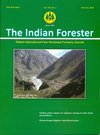Chemical Composition of Foliage of Exotic Seabuckthorn (Hippophae rhamnoides ssp. Mongolica)
DOI:
https://doi.org/10.36808/if/2018/v144i2/122521Keywords:
Nitrogen Fixing, Fodder Value, Livestock, Crude Protein, Exotic, Foliage.Abstract
The present study was carried out on the fodder values of Indian form of seabuckthorn (Hippophae rhamnoides ssp. turkestanica) and an exotic seabuckthorn (H. rhamnoides ssp. mongolica) growing at the farm area of Regional Station of Himachal Pradesh Agricultural University, located at Kukumseri (Altitude 2650 m asl) in district Lahaul-Spiti, a cold desert region of Himachal Himalayas. Crude protein content in the leaves of Indian and exotic forms was similar in May month (30.4% and 29.3% respectively) and it declined to a minimum of 22.8% and 22.3%, respectively in October. EE value increased progressively and it was initially higher in local form (3.5%) than the exotic form (2.5%), however it increased more significantly (P<0.05) in the exotic form (9.6%) than the local form (5.6 %) in October month. ADF values were initially similar, in local form, ADF values decreased significantly (P<0.05) from May (16.4%) to October (14.2%), whereas in exotic form, it was maximum in September (17.5%). NDF value was significantly (P<0.05) higher in local form (29.0%) than the exotic form (26.4%) and it declined in subsequent months, whereas in exotic form, it was maximum (28.6%) in September. Ash content in the local form (10.2%) was significantly (P<0.05) higher than the exotic form (7.5%) and increased to maximum in October (11.1 and 9.8 % respectively) in both cases. High contents of CP and EE and moderate contents of other nutrients make both forms of Seabuckthorn a useful fodder for the livestock of cold desert Himalayas. Seabuckthorn leaves should be preserved as quality feed for livestock during winter.References
AOAC (1984). Official Methods of Analysis. Association of Analytical Chemists. Arlington, Virginia, USA.
Rongsen L. (1992). Seabuckthorn- A multipurpose plant species for fragile mountains. ICIMOD Occasional Paper, No. 20, Kathmandu, Nepal.
Rongsen L. (1998). Nutritive components of the leaves of Hippophae in China and their possible utilization. ICRTS Newsletter, 3: 15-17.
Singh V. (1994). A report on arboreal seabuckthorn (Hippophae salicifolia) from dry temperate Himalayas. J. Tree Sciences, 3: 67-68.
Singh V. (1995). Rooting rates of hardwood cuttings of seabuckthorn (H. rhamnoides). J. Tree Sciences, 14: 87-88.
Singh V., Singh B. and Awasthi C.P. (1995). Distribution, taxonomy and nutritional value of seabuckthorn (Hippophae L.) in dry temperate Himalayas. In: Proc. Int. Workshop Seabuckthorn, p. 52-59, Beijing, China.
Singh V. and Dogra K.K. (1996). Characteristics, utilization, regeneration, biomass yield and nutritional value of seabuckthorn. Indian Forester, 122(6): 486-491.
Singh V. (1998). Fodder values of trees and shrubs of Lahaul. Annual Progress Report, p.27-28, Regional Research Station, Kukumseri (Lahaul and Spiti), H.P.
Singh V., Singh R.K. and Singh B. (1999). Fodder values of foliage of seabuckthorn growing in Lahaul valley, dry temperate Himalayas. In: Proc. Int. Workshop Seabuckthorn, p.55-59, Beijing, China.
Downloads
Downloads
Published
How to Cite
Issue
Section
License
Unless otherwise stated, copyright or similar rights in all materials presented on the site, including graphical images, are owned by Indian Forester.





